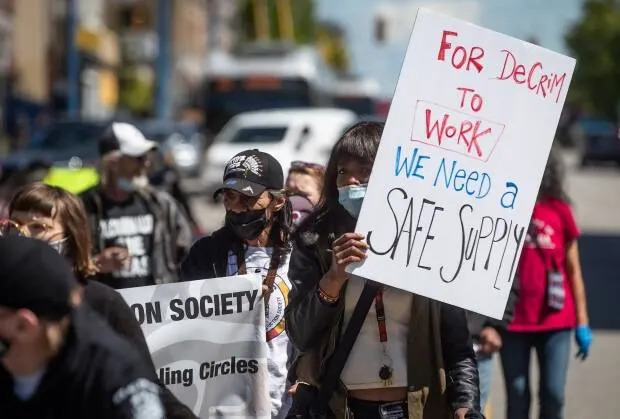Whooping cough outbreak declared in Alberta — symptoms and prevention explained
Late last week, Alberta Health Services (AHS) declared an outbreak of pertussis.
Julia Ranney
·Lifestyle Editor
Mon, January 30, 2023
Whooping cough is on the rise in parts of southern Alberta. (Photo via Getty Images)
This article is for informational purposes only and is not a substitute for professional medical advice, diagnosis or treatment. Contact a qualified medical professional before engaging in any physical activity, or making any changes to your diet, medication or lifestyle.
Amidst COVID-19, RSV, the flu and the common cold, there's another condition on the rise — whooping cough.
Late last week, Alberta Health Services (AHS) declared an outbreak of pertussis — better known as whooping cough — in parts of southern Alberta.
The bacterial infection causes severe coughing that can last for weeks and is easily transmissible. Infants are most at risk of serious complications such as pneumonia, convulsions, brain damage and even death.
At this time, the communities impacted involve those spanning the County of Lethbridge, Coaldale, Taber, Vauxhall, Grassy Lake and Bow Island.
"These are communities with significantly low childhood immunization rates," AHS said in a statement.
Getting vaccinated is one way of preventing whooping cough. (Photo via Getty Images)
According to the AHS, immunization is the best method to protect against and limit the spread, along with regular hand washing and not sharing drinks, food or cutlery.
"Pertussis immunization is safe and effective against preventing severe illness," they added.
Currently, sixteen cases of pertussis have been identified in the South Zone. Of these cases, three patients have required hospitalization.
The pertussis vaccine is free for all Albertans under 18 years of age, individuals in the third trimester of pregnancy (27 weeks) and adults who have not had a tetanus booster in the past 10 years.
For other parts of Canada, refer to your provincial health website for information on the pertussis vaccine.
Read on to learn more about the condition, as well as its symptoms, risks and prevention.
Whooping cough is transmitted through respiratory droplets. (Photo via Getty Images)
What is whooping cough?
According to Public Health Ontario (PHA), whooping cough is "an acute infection of the respiratory tract caused by the bacteria Bordetella pertussis."
The condition is transmitted through respiratory droplets. An infected person spreads it by coughing and sneezing. The coughing can be so intense that a "whooping" sound happens when you try to catch your breath.
According to the Government of Canada, each year between 1,000 and 3,000 Canadians fall ill from pertussis. Worldwide, there are about 20 to 40 million cases of and 400,000 deaths from pertussis each year.
Without treatment, pertussis can last for weeks or months, and can cause brain damage or even death.
The condition is most dangerous for children under one year old, especially if they are unvaccinated. In some cases, whooping cough can lead to worse complications like pneumonia.
What are the signs and symptoms of whooping cough?
PHA explains that whooping cough symptoms start small and consistently get worse.
The condition will initially present as a mild respiratory illness featuring a mild fever, runny nose, red watery eyes and a cough, which progresses to "prolonged cough episodes." During the episodes, choking or vomiting is sometimes present.
For older children and adults, pertussis symptoms may be less severe. They may appear as cold-like symptoms with a cough that lasts longer than a week.
If you or someone you know has a severe or prolonged cough, or any of the above symptoms, see a health care provider as soon as you can.
Whooping cough will initially present as a mild respiratory illness.
Why is there a rise of whooping cough?
While there could be a plethora of factors leading to the rise of whooping cough in Alberta, there's one main factor contributing to the large number of cases in the area: a lack of vaccinations.
"By age two, children should have received four doses of pertussis vaccine, and in some of these areas only one -third of two-year-old children have," the AHS revealed, drawing attention to the fact that many children in the area are unprotected from the condition.
Moreover, as whopping cough is extremely contagious, it's likely spread in schools or public settings where children and infants congregate.
Refer to Health Canada for more information on where and how to get your whooping cough vaccine.
Who is at risk of whooping cough?
While can get whooping cough, it is most dangerous for infants under the age of one.
As immunization programs begin at two months, infants under two months of age are vulnerable. Those who are most at risk for pertussis are children who are not vaccinated or under-vaccinated.
Additionally, pregnant women in the third trimester or individuals with chronic respiratory illnesses are also more at risk.
Other than infants, pregnant women in the third trimester are at risk of whooping cough. (Photo via Getty Images)
How can I help prevent whopping cough?
To prevent whooping cough, Health Canada recommends infants and children get the vaccine.
A child under six years old needs five doses of the pertussis vaccine, starting at two months of age. As protection lessens over time, so it's important to get a booster dose.
You may need a booster for pertussis if you are between 14 and 16 years of age, you are an adult and you were not immunized against pertussis, or if you are between 27 and 32 weeks of pregnancy.
Additionally, if you interact with infants and children on a regular basis, it's very important to be vaccinated.
Outside of the vaccine, other ways to help prevent whooping cough are to consistently wash your hands, refrain from sharing food, drinks or cutlery, and covering your nose and mouth when coughing or sneezing.











